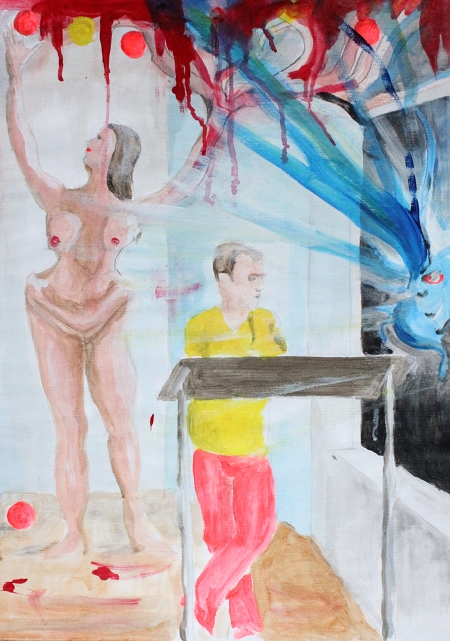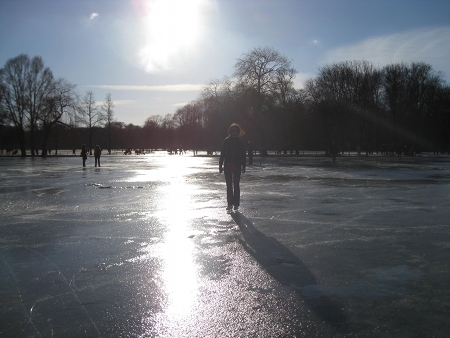au courant
Friday, October 5th, 2012
image by Curtis Neveu on wikipedia
About five years ago there was on randform a question regarding the possibility to study the electron transport in a pigment-protein complex via some optical methods in the attosecond regime. Understanding this may be important for the development of new types of solar cells. From the randform post:
It would be interesting to know wether such high temporal resolution could also be used for investigating electron tranfer in pigment-protein complexes such as in a
photosynthetic reaction center (see image above)(correction 05.10.2012: in a FMO complex (the reaction center seems to be a part of this complex)), which was done by researchers in Berkeley e.g. in a 3 pulse two-color electronic photon echo experiment with 750 and 800 nm pulses in the femtosecond range (science 316 (5830)) or wether the high energies of the corresponding laser pulses would alter the corresponding structures, which apparently happenes if one shoots with gamma rays on a pigment.
In a press release which reports about measurements at the photosystem 1 (PS 1) protein (which appears to be even more complex than the above mentioned FMO complex) it seems that one can at least measure the speed of charges in a photosystem with the help of optical devices.
Not only the press release but even the article itself:
Photocurrent of a single photosynthetic protein, by Daniel Gerster, Joachim Reichert, Hai Bi, Johannes V. Barth, Simone M. Kaniber, Alexander W. Holleitner, Iris Visoly-Fisher, Shlomi Sergani & Itai Carmeli
is actually still currently available on the nature nanotechnology website.
The results of their research makes the researchers write (see article):
Our results demonstrate that individual PS I units can be integrated and selectively addressed in nanoscale photovoltaic devices while retaining their biomolecular functional properties. They act as light-driven, highly efficient single-molecule electron pumps that can function as current generators in nanoscale electric circuits.
Instead of directly shooting with lasers the researchers were here however “exciting the PS 1 with a “633 nm laser light with a power of ~4 mW “from the back of the tip” (see figure 1 in the article), which I understand as that the laser light went through the glass of the tip of a scanning near-field optical microscope before it entered the PS 1 (the PS 1 was “glued” via cysteine mutation groups to the glass tip). Moreover the light makes electrons travel through the protein (as I understand with the help of a voltage through the protein i.e. between the tip and the ground) and this can be measured as a current:
The photocurrent was measured by means of a gold-covered glass tip employed in a scanning near-field optical microscopy set-up. The photosynthetic proteins are optically excited by a photon flux guided through the tetrahedral tip that at the same time provides the electrical contact.
The researchers sketched out the whole reaction-centre electron transfer chain and showed electron transfer and recombination times (see figure 2). I didn’t understand where the detailled knowledge for this figure came from, however their measurement seems to be in good agreement with this knowledge, they write:
One of the most significant results in our experiment is the intriguingly large value of ~10 pA for Iphoto. This translates into a turnover time of ~16 ns; in other words, every ~16 ns, an electron transverses the PS I covalently bound between the two electrodes.
(remark: with electrodes the researchers mean here probably the tip and the ground)
The wavelength in the experiment was 633 nm laser light with a power of ~4 mW but I have no feeling how the light is altered by the scanning near-field optical microscope. In particular I still don’t know wether one could use the high resolution laser pulses to investigate the traveling electrons within a photo system without destroying the photo systems.
Because in principle it seems one could make interesting films with this, similar to what had been done for topological insulators.
addition 090113:
It seems there are already some applications underway, which use PS1, which seems also to be up for a patent. I can’t read the original article , but there is some english description e.g. on nanowerk. Found via Sascha Peters on Liligreen.
I haven’t written this explicitly, but may be I should. PS1 is interesting not only because it has a high quantum efficiency (here a current record for quantum efficiency in quantum dots) and because it is usually available in ecofriendly materials like spinach but amongst others also because it seems that the charge carrier separation works rather well. The above work seems to be amongst others probably concerned with studying the involved mechanisms of charge carrier separation, i.e. last but not least it is concerned with the mechanisms of electron transfer.
On that issue I had written five years ago: “electron transfer in the photosynthetic reaction center of Rhodobacter sphaeroides in the above experiment seems to be highly efficient due to the long coherence between the exiton states of two chromophores corresponding to the bacteriochlorophyll b (BChl-b) molecules and bacteriophaeophytin b molecules (BPh) of a photosynthetic reaction center.”” (the comment was based on observations of the Fleming group) but I haven’t found the time and means to look into these mechanisms much further.
addition 24072014:
There is a new article in nature concerned with some of the above questions, in which Serial time-resolved crystallography of photosystem II using a femtosecond X-ray laser is used to investigate the catalytic processes in photosystems. I can’t read the article, but only the abstract and look the images, but that is already quite interesting. In particular concerning the above comment about the correlations one sees in image c how the spatial configuration of the molecules in the electron transfer chain looks like. After the photosystem II primary donor P680 one sees achlorophyll Chl_A and then a pheophytin Pheo_A. In the Wikipedia description of P680 it is written:
The primary donor receives excitation energy either by absorbing a photon of suitable frequency (colour) or by excitation energy transfer from other chlorophylls within photosystem II. During excitation, an electron is excited to a higher energy level. This electron is subsequently captured by the primary electron acceptor, a pheophytin molecule located within photosystem II near P680.
This sounds as if Chl_A is rather in charge of the excitation energy transfer to P680 than as part of the electron transfer from P680 to Pheo_A, which seems different from what the little orange arrows in image c indicates. So a question which arises here is wether one can here observe a long coherence between exiton states of Chl_A and Pheo_A (as it seems it exists for the case of BChl-b and BPh) and wether this involves P680 or not. It seems as if the grid like bubbles in the images g,h,i are eventually charge carrier configurations (? that is those seem to be electron density bubbles upon making a survey on the results of googleing what is an omit map). However I can’t even identify Pheo_A in those images.
addition 19092014:
The question about how the concrete energy transport pathway looks like concretely was raised also on the Azimuth forum
addition 04102017:
I detected an article which explains:
Why Quantum Coherence Is Not Important in the Fenna–Matthews–Olsen Complex
The authors, who apparently use certain Hierarchical equations of motion techniques claim:
Our exact results are then compared to calculations using the incoherent Förster theory, and it is found that the time scale of energy transfer is roughly the same, regardless of whether or not coherence is considered. This means that coherence is not likely to improve the efficiency of the transfer. In fact, the incoherent theory often tends to overpredict the rates of energy transfer, suggesting that, in some cases, quantum coherence may actually slow the photosynthetic process.
Remark: There exists now a Förster resonance energy transfer on Wikipedia, but I don’t know in how far this is related to (incoherent) “Förster theory”.
addition 22092022:
Researchers try to find artificial alternatives to the movements of excitons in plants. Here an approach with polaritons.
( B. Liu et al., “Photocurrent generation following long-range propagation of organic exciton-polaritons,” Optica 9, 1029 (2022).)



